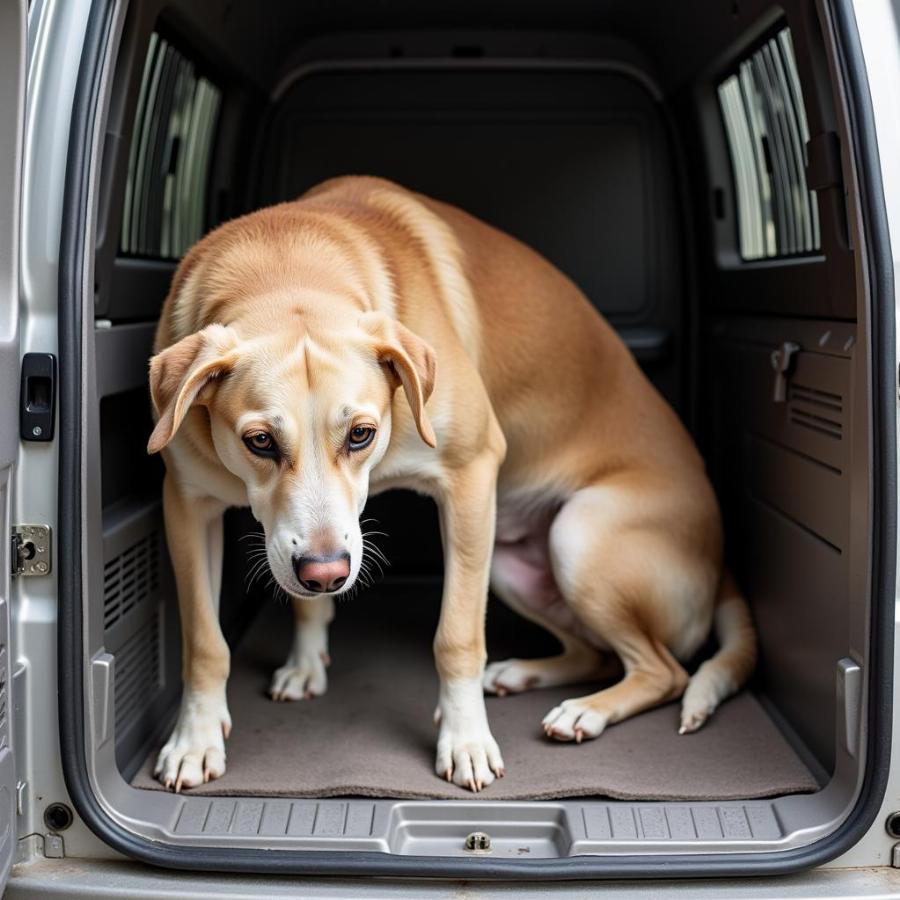A dog crate, when used correctly, can be a safe haven, a helpful training tool, and a comfortable den for your furry friend. But a dog crate too small can lead to discomfort, anxiety, and even health problems. So, how do you know if your dog’s crate is the wrong size? This article will help you identify the telltale signs of a cramped crate, guide you through choosing the right size, and offer solutions for making your dog’s den a place they truly love.
Signs Your Dog’s Crate is Too Small
Determining if your dog crate too small isn’t always obvious. Your dog can’t tell you they’re uncomfortable, so you need to look for clues. Is your dog constantly trying to escape? Are they whining, barking, or showing signs of stress when crated? These could be signs of a size issue. Physical signs are even more telling. If your dog can’t stand up straight, turn around comfortably, or lie down fully extended without touching the sides, their crate is definitely too small. Hunched posture, difficulty getting in or out, and rubbing or scraping against the crate’s walls are other red flags.
 Dog Showing Signs of Discomfort in a Crate Too Small
Dog Showing Signs of Discomfort in a Crate Too Small
Choosing the Right Size Crate
Choosing the right size crate is crucial for your dog’s well-being. The crate should be large enough for your dog to stand up with their head and ears erect, turn around easily, and lie down fully stretched out. For puppies, consider their projected adult size. You can consult breed standards or your veterinarian for an estimate. A lucky dog crate is often a good choice for larger breeds. While you want ample space, avoid a crate that’s too large, as puppies might use one end as a bathroom and the other for sleeping, hindering house-training. Consider using a divider in a larger crate for a growing puppy.
How to Measure Your Dog for a Crate
To accurately measure your dog, have them stand on all fours. Measure from the tip of their nose to the base of their tail (add 2-4 inches for comfort). Then, measure from the floor to the top of their head or ears when standing (add 2-4 inches). These measurements will give you a good starting point for choosing the appropriate crate size. You can also check our guide on xsmall dog collars for smaller breeds.
Solutions for a Crate That’s Too Small
If you realize your dog’s crate is too small, the most obvious solution is to upgrade to a larger one. However, if your dog is still growing, using a divider can be a cost-effective temporary solution. Make sure the divided space still adheres to the sizing guidelines mentioned earlier. Never punish your dog for exhibiting signs of discomfort in a crate that’s too small. This will only worsen their anxiety and create negative associations with the crate.
What If My Dog Still Doesn’t Like the Crate?
Sometimes, even with the right size crate, a dog might still display reluctance or anxiety. This could be due to negative past experiences or a lack of proper crate training. Make the crate a positive and inviting space. Use treats, toys, and comfortable bedding. Never use the crate as punishment. Introduce the crate gradually and positively, starting with short periods and gradually increasing the duration. Consult a certified dog trainer for personalized guidance if you encounter challenges. They can help you address any underlying anxiety and create a positive crate training experience for your dog. Perhaps a comfortable bed would help, similar to those used for dogs who have dog peed on couch incidents.
Why is a Properly Sized Crate Important?
A properly sized crate is essential for both your dog’s physical and mental well-being. A crate that’s too small restricts movement and can lead to joint pain, muscle stiffness, and overall discomfort. It can also increase anxiety and stress, leading to destructive behaviors and difficulty housetraining. A correctly sized crate, on the other hand, provides a secure and comfortable den where your dog can relax and feel safe.
Frequently Asked Questions (FAQ)
-
How do I know if my dog’s crate is the right size? Your dog should be able to stand, turn around, and lie down comfortably.
-
What if I have a puppy? What size crate should I get? Consider their adult size. Use a divider in a larger crate to adjust the space as they grow.
-
My dog hates the crate. What should I do? Positive reinforcement is key. Make the crate inviting with treats and toys. Introduce it gradually and never use it as punishment.
-
Can a crate that’s too small harm my dog? Yes, it can lead to physical discomfort, anxiety, and behavioral issues.
-
Where can I find affordable dog crates? Pet stores, online retailers, and even some shelters offer a variety of crates at different price points.
More Questions?
Need more information on crate training or other dog-related topics? Check out our other articles on schnauzer dog price and temporary dog door.
Conclusion
Ensuring your dog’s crate is the right size is paramount for their comfort and happiness. By recognizing the signs of a too-small crate and understanding how to choose the correct size, you can create a positive and enriching environment for your furry companion. Remember, a properly sized crate is not a cage; it’s a safe, comfortable den where your dog can relax and feel secure. If you have further questions, don’t hesitate to reach out to a qualified professional.
Beaut Dogs is your one-stop resource for all things dog-related, from breed information to training tips and product reviews. We are dedicated to providing reliable, accurate information to help you navigate the wonderful world of dog ownership. When you need assistance, contact Email: [email protected] to receive detailed and accurate answers from Beaut Dogs. https://beautdogs.com.